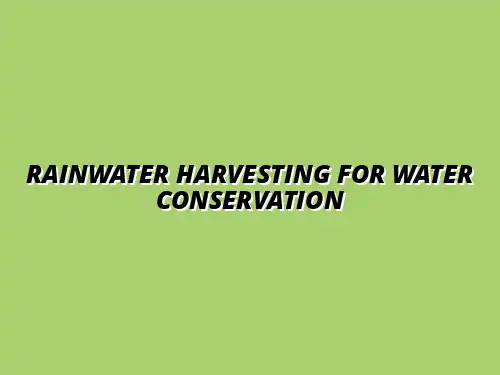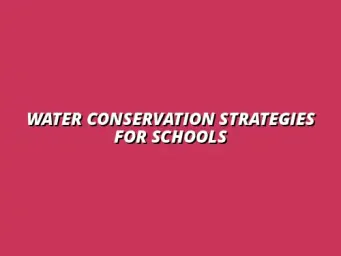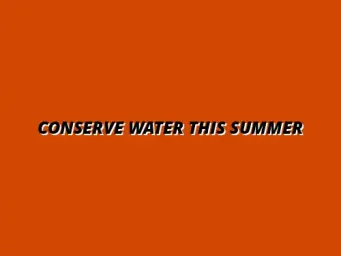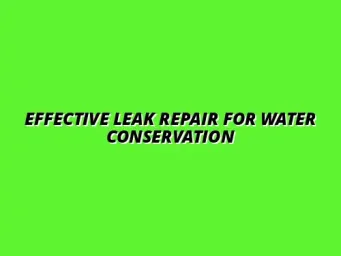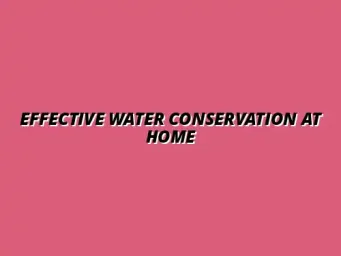Understanding Rainwater Harvesting and Its Role in Water Conservation
Rainwater harvesting is an approach that allows us to collect and store rainwater for future use. This practice not only helps in conserving water but also plays a vital role in managing our water resources sustainably. By understanding rainwater harvesting, we can appreciate its significance in today's world, especially as we face increasing water scarcity. For practical tips on reducing your daily water waste, check out these water-saving tips.
Defining Rainwater Harvesting and Its Importance
What is Rainwater Harvesting?
At its core, rainwater harvesting involves capturing rainwater from surfaces like roofs and directing it into storage systems. This collected water can be used for various purposes, such as irrigation, flushing toilets, and even drinking after proper treatment. The process is relatively simple and can be adapted to different environments, making it a versatile solution for water conservation.
Rainwater harvesting is important because it provides an alternative water source that can alleviate pressure on traditional water supplies. It allows us to utilize a free and abundant resource, reducing our reliance on municipal water systems and groundwater. Ultimately, this practice contributes to a more sustainable and resilient water supply system.
Historical Context of Rainwater Harvesting Practices
Rainwater harvesting has been practiced for thousands of years across various cultures. Ancient civilizations, such as the Greeks, Romans, and Chinese, developed systems for collecting rainwater to support their communities. They recognized the value of this natural resource long before modern technology made it easier to implement such systems.
Today, many areas are revisiting these ancient practices as we confront contemporary challenges like drought and over-extraction of groundwater. Learning from the past can inform current strategies, enabling us to create effective rainwater harvesting systems that honor tradition while addressing modern needs.
Benefits of Rainwater Harvesting for Water Conservation
Reducing Dependency on Groundwater and Surface Water
One of the primary benefits of rainwater harvesting is its potential to reduce our dependency on groundwater and surface water sources. By capturing rainwater, we can lessen the strain on these critical resources, especially in regions facing water shortages. This practice not only helps in preserving existing water supplies but also promotes a more balanced ecosystem. Implementing green plumbing solutions can further enhance water savings.
- Decreases pressure on aquifers and rivers
- Encourages responsible water use
- Promotes drought resilience
Moreover, by using rainwater for non-potable purposes, such as landscaping and washing vehicles, we can save drinking water for situations where it is truly necessary. This dual approach to water use benefits both the environment and our communities.
Minimizing Water Waste and Loss in Urban Areas
Urban areas often face high levels of water waste due to inefficient infrastructure and high consumption rates. Rainwater harvesting can help mitigate this issue by providing an alternative source of water that reduces runoff and flooding. Effective urban drainage solutions, like those discussed on this page, are crucial: Urban Sustainable Drainage Solutions. When we capture rainwater from rooftops and paved surfaces, we can significantly lower the amount of waste entering drainage systems.
- Reduces stormwater runoff
- Enhances urban green spaces
- Improves water quality by filtering pollutants
By implementing effective rainwater harvesting systems, cities can not only conserve water but also promote healthier urban environments. This practice fosters a culture of sustainability, encouraging residents to engage in water-saving behaviors.
How Rainwater Harvesting Works
Components of a Rainwater Harvesting System
A rainwater harvesting system typically consists of several key components that work together to capture and store water. Understanding these components is essential for effective system design and implementation. Here’s a breakdown of the main parts:
- Catchment Area: Usually a rooftop or paved surface where rainwater is collected.
- Conduits: Pipes or gutters that direct the collected rainwater to storage tanks.
- Storage Tanks: Containers that store the harvested rainwater for later use.
- Filtration System: Equipment designed to clean the rainwater before it is used.
These components can be customized based on the specific needs of a household or community. When combined effectively, they create a comprehensive system that maximizes the benefits of rainwater harvesting.
The Collection and Filtration Process
The process of collecting and filtering rainwater is crucial for ensuring its quality and usability. First, rainwater is collected from the catchment area, then it flows through the conduits into the storage tanks. To make sure the water is safe for use, it goes through a filtration system that removes debris, dirt, and other contaminants.
It's essential to monitor the filtration process regularly to maintain water quality. Implementing a first-flush diverter can also be beneficial, as it ensures the initial runoff, which often contains more pollutants, is not included in the stored water. This practice significantly enhances the overall effectiveness of the rainwater harvesting system. Regular maintenance of your home plumbing can prevent many emergencies; find tips here: Prevent Plumbing Emergencies with Maintenance.
Rainwater Harvesting Techniques and Methods
Above-Ground vs. Below-Ground Systems
When it comes to rainwater harvesting, there are two primary methods: above-ground and below-ground systems. Each has its own advantages and considerations, making it important to choose the right option for your specific circumstances. Here’s a quick comparison:
| Feature | Above-Ground Systems | Below-Ground Systems |
|---|---|---|
| Installation Cost | Generally lower | Typically higher |
| Space Requirement | Less space needed; can be placed in smaller areas | Requires more space for excavation |
| Maintenance | Easier access for cleaning | More challenging due to underground placement |
Choosing between these systems often depends on a variety of factors, including available space, budget, and personal preferences. Both methods can effectively contribute to water conservation efforts. Learn more about efficient water heater maintenance to further reduce your water usage: Maintain Your Water Heater Efficiently.
Innovative Approaches to Rainwater Storage
As technology advances, new and innovative approaches to rainwater storage are emerging. Some methods incorporate smart technology to monitor water levels and quality. Others focus on integrating rainwater systems into existing infrastructure, making them more efficient and user-friendly.
- Smart sensors to monitor storage levels
- Green roofs that absorb and store rainwater
- Permeable pavements that allow water to infiltrate the ground
These cutting-edge techniques not only enhance the effectiveness of rainwater harvesting systems but also promote greater community engagement in water conservation efforts. By staying informed about these innovations, we can find new ways to conserve water and protect our environment.
Regulatory and Environmental Considerations
Legal Framework Surrounding Rainwater Harvesting
The regulations governing rainwater harvesting can vary significantly by region. Some areas encourage the practice through incentives, while others may have strict guidelines that must be followed. Understanding the legal framework is essential for anyone looking to implement a rainwater harvesting system.
It’s important to check local laws and regulations regarding rainwater use, permits, and water quality standards. Adhering to these guidelines ensures that the system is both effective and compliant with environmental standards.
Impact on Local Ecosystems and Biodiversity
Rainwater harvesting can have positive effects on local ecosystems when implemented correctly. By capturing rainwater, we can reduce runoff that often carries pollutants into rivers and lakes. This practice helps to maintain water quality and protect aquatic habitats.
- Improves soil moisture levels
- Supports local plant growth
- Encourages wildlife habitats
However, it’s essential to consider the potential impacts on biodiversity as well. Sustainable practices should be employed to ensure that the benefits of rainwater harvesting extend to the surrounding environment. For more water saving tips for your home, visit: Water Saving Tips for Your Home.
Common Misconceptions About Rainwater Harvesting
Addressing Myths Surrounding Health and Safety
There are several misconceptions about the health and safety of using harvested rainwater. One common myth is that rainwater is inherently unsafe for consumption. In reality, when properly collected and treated, rainwater can be safe for drinking and other purposes.
To dispel these myths, education is crucial. By informing communities about proper collection, filtration, and treatment methods, we can promote greater acceptance of rainwater harvesting as a viable option for water conservation.
Clarifying Cost and Maintenance Concerns
Many people believe that rainwater harvesting systems are too expensive to install and maintain. While there is an initial investment, the long-term savings on water bills and reduced reliance on external sources can outweigh these costs. Additionally, maintenance can be minimal with proper system design.
- Regularly clean filters and gutters
- Inspect storage tanks for leaks
- Monitor water quality periodically
By clarifying these concerns, we can encourage more individuals and communities to consider rainwater harvesting as a beneficial investment for the future. For information on plumbing services in Great Barr, Birmingham, see: Plumber in Great Barr, Birmingham.
Implementing Rainwater Harvesting: Practical Applications and Challenges
Implementing a rainwater harvesting system can be a rewarding experience. It not only promotes sustainability, but it also contributes to efficient water management in your home or business. However, there are a few important steps to ensure that your system is effective and meets your needs.
In the following sections, we'll look at the steps to create a robust rainwater harvesting system, real-world applications, and challenges that may arise during implementation. I'll also cover frequently asked questions and future trends to give you a comprehensive understanding of the topic!
Steps to Create an Effective Rainwater Harvesting System
When you're ready to set up a rainwater harvesting system, it’s essential to follow a series of steps to ensure its success. First, you need to evaluate your property to determine the best way to collect and store rainwater. This involves considering various factors related to your environment and needs.
Assessing Your Property for Rainwater Collection
Start by assessing your property’s surface area that can be utilized for collecting rainwater. Look for:
- Roof Type: Different roofing materials affect the quality of collected rainwater.
- Drainage Systems: Ensure existing drainage systems can complement your collection efforts.
- Storage Options: Identify where you can place tanks or cisterns without disrupting the landscape.
Once you know where to collect rainwater, you can move on to the next steps!
Choosing the Right Equipment and Materials
Next, you’ll want to choose suitable equipment and materials for your system. This includes:
- Collection Tanks: Select the right size based on your needs and available space.
- Filters: Invest in quality filters to ensure clean water for your use.
- Pipes and Gutters: Ensure proper installation to maximize water flow.
By carefully selecting the right equipment, you will enhance the efficiency of your rainwater harvesting system!
Real-World Applications of Rainwater Harvesting
Rainwater harvesting isn’t just theoretical; it’s in real use across various settings, providing practical solutions to water scarcity. Homeowners and businesses alike can benefit from implementing these systems, leading to significant savings and environmental impact.
Residential Settings: Homeowner Experiences and Benefits
Many homeowners have found success with rainwater harvesting, leading to benefits such as:
- Lower Water Bills: Collecting rainwater reduces dependency on municipal supplies.
- Watering Gardens: Rainwater is often better for plants as it is free from chemicals.
- Emergency Supply: It can provide a backup water source during droughts or supply disruptions.
These experiences highlight how beneficial rainwater harvesting can be in everyday life!
Commercial and Public Sector Initiatives in Water Conservation
On a larger scale, businesses and public sectors have also adopted rainwater harvesting systems, showing a commitment to sustainability. Examples include:
- Schools: Many schools collect rainwater for irrigation and flushing toilets.
- Retail Stores: Large retailers often implement systems to reduce water costs.
- Parks and Recreation Areas: Collecting rainwater helps maintain green spaces with less environmental impact.
Such initiatives not only help in conserving water but also serve as a model for responsible resource management.
Addressing Frequently Asked Questions About Rainwater Harvesting
As rainwater harvesting becomes more popular, many people have questions about its safety, usage, and costs. It’s important to address these queries to clear up any confusion.
Can Rainwater be Used for Drinking? Understanding Purification
The short answer is yes, but it typically requires proper purification techniques. Rainwater can be safe to drink if it is:
- Filtered: Impurities must be removed.
- Stored Safely: Tanks should be sealed to prevent contamination.
- Treated: Additional treatment may be necessary for complete safety.
Understanding these steps can help you decide how to use harvested rainwater effectively!
What Are the Costs Involved in Setting Up a System?
Setting up a rainwater harvesting system can vary in cost based on several factors. Here are some common expenses to consider:
- Equipment Costs: This includes tanks, filters, and pipes.
- Installation Costs: Hiring professionals can increase expenses.
- Maintenance Costs: Regular checks and cleaning are necessary for longevity.
Understanding these costs can help you budget accordingly!
Future Trends in Rainwater Harvesting and Water Conservation
As technology evolves, so does rainwater harvesting. Future trends point toward innovative solutions that enhance water conservation efforts. These advancements may lead to even greater efficiency and effectiveness.
Technological Advancements Enhancing Rainwater Harvesting
Emerging technologies are making rainwater harvesting systems smarter and more efficient. Some exciting trends include:
- Smart Sensors: These can monitor water levels and quality in real time.
- Automated Systems: Systems that can automatically switch between rainwater and municipal water.
- Data Analysis: Enhanced data collection to optimize water usage over time.
These advancements will likely make rainwater harvesting even more accessible and user-friendly!
The Role of Community Engagement in Promoting Water Conservation
Community involvement is crucial for widespread adoption of rainwater harvesting systems. Initiatives to engage residents include:
- Workshops: Educating the public on the benefits and implementation.
- Incentives: Offering financial help or rebates for system installation.
- Collaborative Projects: Communities working together to set up large-scale systems.
By fostering a sense of community, we can enhance our collective efforts toward sustainable water management!
Summarizing the Impact of Rainwater Harvesting on Water Conservation
In conclusion, rainwater harvesting plays a vital role in water conservation efforts. It provides practical solutions for both residential and commercial needs while promoting a sustainable approach to resource management.
Key Takeaways on the Importance of Sustainable Water Management
Here are some key points to remember:
- Resource Efficiency: It reduces reliance on traditional water sources.
- Environmental Benefits: Helps mitigate flooding and erosion.
- Community Impact: Encourages collective responsibility towards water conservation.
By embracing these practices, we can significantly impact our planet’s health!
Encouraging Local and Global Efforts Toward Water Conservation
Lastly, it's essential to promote rainwater harvesting not just locally but also globally. Encouraging individuals and communities to adopt these systems can lead to a concerted effort in tackling water scarcity issues. Together, we can work towards a more sustainable future!

